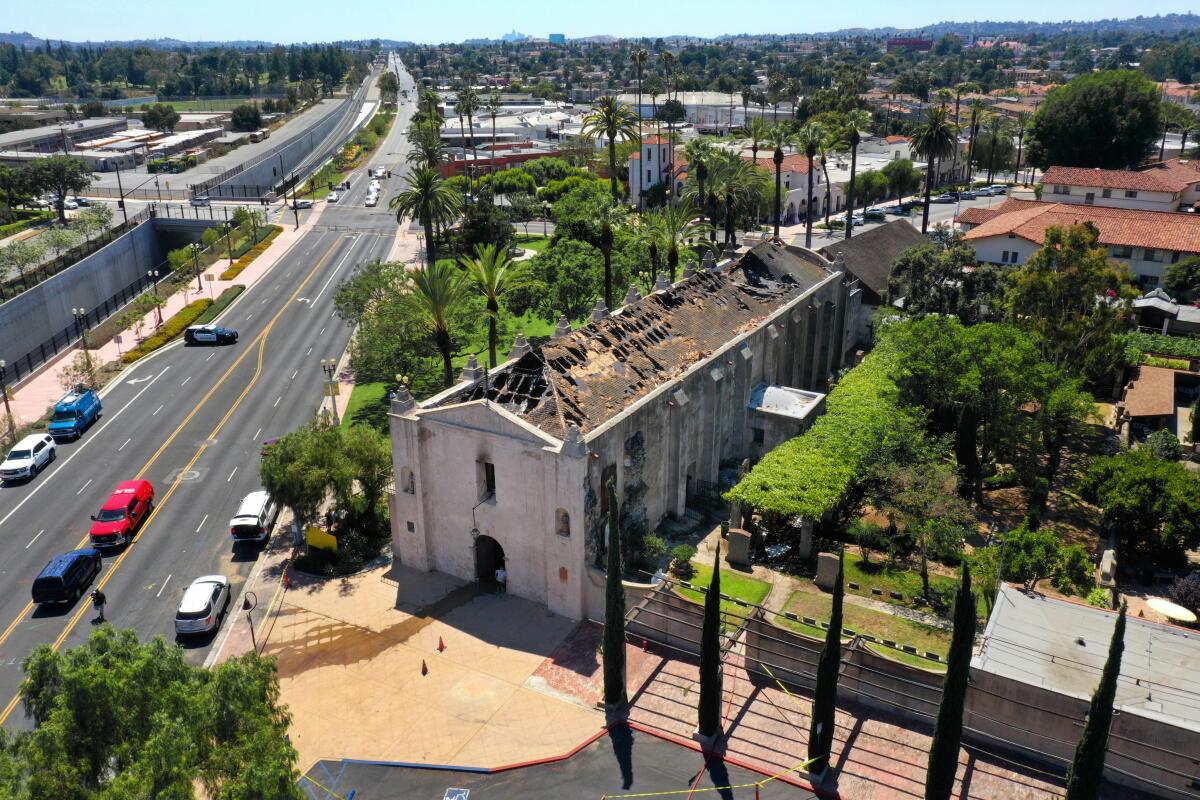What the fire at San Gabriel Mission left behind

- Share via
San Gabriel Mission burned Saturday. The mission, although outside the city, is central to the identity, imagination and complicated colonial past of Los Angeles. L.A. only occasionally grapples with that complexity. It is easier to simplify, to reduce the missions to Junipero Serra, whose statue until a few weeks ago stood in front of the mission, and to view Serra as saint or genocidal killer. These tend to be the terms of current debate, but the mission — and the people who have frequented it for two centuries — are way more complicated than that.
The fire, having reduced the mission to a partial ruin, paradoxically forces us to see the mission for all that it is. San Gabriel is among the sites my son, Jesse, who is a photographer, and I have been looking at for the last five years. We were doing a book about California’s past that sits hidden in plain sight.
Now a few hours of heat and flame have made some of Jesse’s photographs historical. The mission remains, but much of the interior of the church that he photographed has ceased to exist.
The tangled past remains too. The first newspaper reports about the fire said the church was 249 years old, but the building is younger. The original mission on the Rio Hondo — from which the party of pobladores, priests and soldiers who founded Los Angeles in 1781 departed — was abandoned because of flooding. The current mission was begun in 1794 and finished in 1806. This is not the first time it was partially destroyed. It suffered substantial damage in the great earthquake of 1812.
Look closely and you see the church has a Moorish and Muslim air. Father Antonio Cruzado, who oversaw its construction, copied the almenas that cap the pillars from the cathedral at Córdoba, his birthplace in Spain. That cathedral had once been a mosque.
California began with a conquest, and the mission itself echoes the earlier Muslim conquest of Spain and a Christian reconquest, but it gets even more tangled than that. At San Gabriel the past creates a vortex that makes it easy to slip back to 18th-century Mexico, medieval Spain and the ancient Near East, forgetting that this was an Indian church. At masses, Indians, willingly or unwillingly, filled the church. Rarely can we name them, but at San Gabriel, Miguel Blanco, from the Baja missions and a master mason, supervised construction. Remigio, a San Gabriel neophyte, assisted him.
Gabrieleños built the mission and they rebelled against it, led by Nicolás José, who had been baptized and became an alcade, and Toypurina, who was a female shaman. She was exiled after the suppression of the rebellion. She was baptized later, changed her name to Maria Regina, married a soldier and had four children. Some of her descendants identified as Californios. Identities change.
Many of the modern Gabrieleños remain Catholic, and even those that don’t recognize their past in the mission. When I was visiting the mission, Julia Bogany, a Gabrieleño/Tongva elder, led special tours there.
The devastation of the Tongvas and others owes much to the missions, but just as much to the Mexicans and Americans who succeeded the Spanish. They were the ones who took Gabrieleño land, exploited Gabrieleño labor, and forced many of the survivors into exile. Our obsession with Serra disguises all this.
San Gabriel helped create modern Southern California as well as El Pueblo de Nuestra Señora la Reina de Los Ángeles. It was central to the mission myth that turned the missions into tourist destinations.
And San Gabriel continues to reflect modern Los Angeles. The masses, temporarily displaced from the church first because of the pandemic and now the fire, were in English, Vietnamese, and Spanish.
Look hard at the mission. It is remarkable how much you can see.
Richard White is an emeritus professor of history at Stanford University. His latest book, with photographer Jesse Amble White, is “California Exposures: Envisioning Myth and History.”
More to Read
A cure for the common opinion
Get thought-provoking perspectives with our weekly newsletter.
You may occasionally receive promotional content from the Los Angeles Times.









